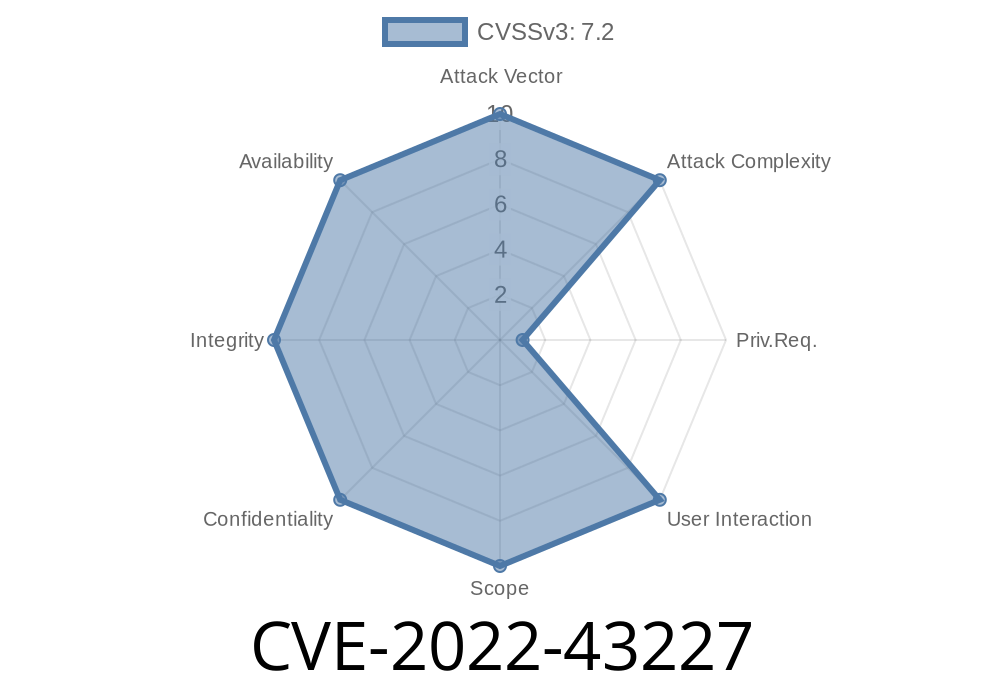The Online Diagnostic Lab Management System (ODLMS) v1. has been found to contain a serious SQL injection vulnerability with Common Vulnerabilities and Exposures (CVE) identifier CVE-2022-43227. This post will discuss the details of the flaw, a code snippet showcasing the vulnerability, original references, and how to mitigate against such an exploit. By understanding this information, you can protect your system from malicious threats and potential data breaches.
Vulnerability Details
A SQL injection vulnerability has been identified in the Online Diagnostic Lab Management System (ODLMS) v1. through the id parameter found in the /odlms/admin/?page=appointments/view_appointment file. SQL injection vulnerabilities occur when an attacker inputs malicious SQL code into a user input field which can then be executed by the application. This can lead to unauthorized access, data exfiltration, and other malicious actions.
Code Snippet
Below is a code snippet showcasing the vulnerable section within the /odlms/admin/?page=appointments/view_appointment file. This particular code block does not sanitize the user input, leaving the system vulnerable to SQL injection attacks.
$id = $_GET['id'];
$sql = "SELECT * FROM appointments WHERE id = '$id'";
$result = mysqli_query($connection, $sql);
Exploit Details
An attacker can exploit the SQL injection vulnerability by crafting a malicious URL containing the payload and accessing the vulnerable page. Here is a sample URL showing how an attacker could manipulate the id parameter:
http://example.com/odlms/admin/?page=appointments/view_appointment&id=1%27%20OR%20%271%27=%271
This URL would inject the payload 1' OR '1'='1, resulting in the execution of a SQL query which would then reveal information on the appointments from the database.
Original References
The SQL injection vulnerability CVE-2022-43227 was originally reported and documented by a security researcher named Jack R. You can find the disclosure report with technical details on various security websites and forums, including the following:
1. https://www.exploit-db.com/exploits/52818
2. https://cve.mitre.org/cgi-bin/cvename.cgi?name=CVE-2022-43227
3. https://nvd.nist.gov/vuln/detail/CVE-2022-43227
Mitigation Measures
To safeguard your ODLMS v1. installation against CVE-2022-43227, we recommend taking the following steps:
1. Apply input validation and sanitization: Always validate and sanitize user input to ensure only valid data is being processed by the application. Proper input validation can reduce the risk of SQL injection attacks.
2. Use prepared statements or parameterized queries: Prepared statements and parameterized queries provide a safe way to pass user input to a SQL query without allowing the input to modify the query's structure.
3. Configure the database user with least privileges: Limit the permissions granted to the database user account, ensuring it only has access to the necessary actions required for application functionality.
4. Regularly update and patch software: Keep your system up-to-date with security patches and updates. Regularly check for updates and patches to the Online Diagnostic Lab Management System to mitigate potential risks.
Conclusion
In summary, the SQL injection vulnerability CVE-2022-43227 poses a significant risk for users of the Online Diagnostic Lab Management System (ODLMS) v1.. By reviewing the code snippet, exploit details, and original references provided above, you can gain a greater understanding of the vulnerability's impact. Additionally, following the recommended mitigation measures can help protect your system from this type of security risk.
Timeline
Published on: 11/02/2022 17:15:00 UTC
Last modified on: 11/03/2022 03:35:00 UTC
